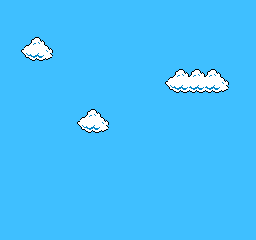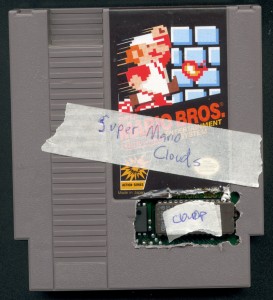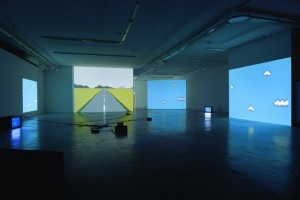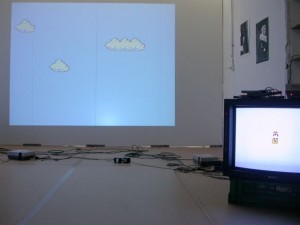Lori Zippay: Perhaps now we should touch on the Clouds in relation to issues of preservation.
Cory Arcangel: Preservation. What a nightmare. (Arcangel & Zippay, 2005)
Cory Arcangel’s 2002 piece Super Mario Clouds is one of the artist’s most well-known works. It has taken several different forms by now, but its core concept is simple: A hacked version of the popular 1985 Nintendo Entertainment System (NES) video game Super Mario Brothers has had all elements removed except for the sky and the clouds, which slowly scroll across the screen forever. The game’s ROM was hacked digitally to create this effect, and then physically instantiated by modifying a copy of its NES cartridge. Arcangel removed the cartridge’s original program chip and soldered in a new chip containing his altered program. The cartridge could then be inserted into an NES console, which would then display the artwork on a connected television.

The piece was first released as web art oriented toward the hacker community. It took the form of a web page containing an animated .gif of the game, photos of the modified cartridge, the complete source code of the hack, the .nes ROM file itself, and a tutorial explaining how the reader could make their own copy of the hacked cartridge (Arcangel 2002). Years later, Arcangel was asked to exhibit Super Mario Clouds as an installation in a gallery setting. He set the piece up as a multi-channel projection, with the projectors hooked up to an NES console, displaying the output from the actual cartridge. The console was intentionally made visible to visitors in order to emphasize the technology behind the installation. As part of the showing, he sold an edition of five physical cartridges of the work, providing the option of purchasing a functional NES console along with it.
As this piece represents a rare, early interaction between the disparate contexts of the art world, Web 1.0, video gaming fandom, and hacker culture, it seems an appropriate candidate for long-term preservation. Luckily, its creator is very familiar with the preservation of electronic objects. Arcangel happened to take part in a project to recover and preserve a set of electronic drawings that Andy Warhol had created in the mid-1980’s using an Amiga home computer (See below for an astonishing documentary about that project). With this experience in mind, it’s no surprise that Arcangel has nuanced feelings about the preservation of his own work.
In a 2005 interview, Arcangel spoke in depth about the long-term preservation and future exhibition of Super Mario Clouds. He recommended different approaches for different types of exhibition. He felt that the source code of the ROM could be considered a valid representation of the artwork, and emulating it on a computer would be a sufficient means of displaying it over the internet. However, if the work were to be displayed as a gallery installation, he would prefer to run it off of the original hardware. His reasoning is quite interesting:
The problem with emulation outside of preservation is that people, the public-don’t understand emulation. So if a gallery or museum wanted to run an emulated version I would be really standoffish about it, because I think the point of one of those pieces is so people can see the Nintendo. It’s similar to the magnet on the TV; it’s like, OK, here’s where the signal is coming from, and I think when you run it on an emulator you really lose that. So really the emulation right now is for the specialized audience on the Internet who understands that it normally would be a Nintendo. But the gallery or museum audience doesn’t understand that. The hope is that in twenty or thirty years audiences will understand emulation, so you could show an emulated version in a museum and it wouldn’t be such a big deal. (Arcangel & Zippay, 2005)
Here Arcangel makes a point that I’ve never seen expressed anywhere else. As the rapid cycle of obsolescence in consumer technology continues, outdated mediatypes and file systems will continue to pile up. As older personal and workplace files become more and more difficult to access, the general public will be more likely to understand and use emulation as an increasingly useful digital hygiene practice. This enhanced understanding would affect how audiences perceive gallery shows that employ emulation to display older digital artwork. It could make emulation more viable in situations where this understanding is advantageous, but it could also create a higher demand for the original hardware, as audiences desire to see “the real thing.”

It’s also important to note that the impact of Super Mario Clouds is very much mediated through the viewer’s experience with and recognition of the original Super Mario Brothers video game it modifies. Super Mario Brothers was a huge commercial success, spawned a major franchise, and is widely regarded as a landmark work in video game history. It is likely to stay relevant and recognizable long into the future. Even so, thinking in OAIS terms, if Arcangel were to create a Submission Information Package (SIP) of Super Mario Clouds to be ingested by an archives, I would recommend that he include a copy of the original Super Mario Brothers ROM file that he referenced while creating the work. At the very least, it could provide insight into the coding process by which he and other hackers in his contemporary scene created their works.
I would recommend that this hypothetical SIP (or resulting AIP) also include a copy of Arcangel’s preferred NES emulator he used to in the creation of the work, a copy of the original web tutorial and associated image and ROM files, photos and/or video of the work as displayed in installation form, relevant contextual documents like the interview I referenced earlier, a copy of the physical cartridge, a working NES console, and a CRT television capable of connecting to the console. I would also recommend the SIP include metadata about the work, including its title, creator, date of creation, physical and electronic substrate, etc. All of these elements would ensure that future scholars could obtain a clear understanding of the work, and would provide the necessary resources to stage an effective exhibition of it.
As with any born-digital work, there are a number of short-term risk factors that must be taken into consideration when handling Super Mario Clouds. Obviously, one must keep multiple backups of all related files in multiple physical locations, as many as possible, in order to avoid a catastrophic loss of data. It’s important to employ systems like checksums and cryptographic hashes to monitor the contents of the files, safeguarding them from bit rot or other unsavory modifications.
Currently, the original web page for Super Mario Clouds is down, and, to my knowledge, can only be accessed using the Internet Archive’s Wayback Machine. Luckily, they have archived many versions of the page, and they managed to preserve all of the images and even the .nes ROM file that used to be hosted there. It appears to be a very faithful recreation of the original page. However, any institution hoping to preserve Super Mario Clouds would be wise to keep their own copies of these pages. While the Internet Archive is a very reliable and capable institution, the collecting institution will want to maintain control of its own copy.

In preserving and exhibiting Super Mario Clouds, there is also the risk of encountering copyright trouble. Super Mario Brothers is still under copyright, and Nintendo has not always taken kindly to derivative works created from their properties. Just a few months ago, Nintendo released a new game called Mario Maker, essentially a level editor allowing players to create their own Super Mario Brothers levels. In the run-up to its release, Nintendo began cracking down on derivative works. They issued takedown notices and sent cease and desist letters to various YouTube users who’d uploaded videos of speed runs and rom hacks created from Nintendo games, especially those in the Mario franchise (Hernandez, 2015). While Super Mario Clouds would probably fulfill the legal requirements to be considered fair use, any institution holding it may still be vulnerable to legal challenges. Short of reforming Copyright law (sounds good to me) or waiting for Super Mario Brothers to enter the public domain, there doesn’t seem to be a whole lot that a holding institution could do about this.
As far as medium-term preservation risks go, it’s mainly important to prepare for the potential obsolescence of the .nes file format of the ROM and the potential failure of the physical NES hardware and/or cartridge. Again, Arcangel has considered these risks, and he doesn’t seem too concerned:
With the Whitney I had to give them all of the source code and all the instructions. But for the short term, in my lifetime, I’m not worried about it. [NES consoles] are much more robust than a VCR. You could throw them down the stairs and they still would work. I’m not worried about it for my lifetime, but in a hundred years it’s anybody’s guess. There are no moving parts, which is what’s good about it. The Nintendos I use now are 25 years old and they work fine. You’d be hard pressed to find a VCR that’s 25 years old that works. But the short term is not really even part of the debate. The debate is what happens when there are no more Nintendos. But at that point computers are going to be great. Even now you can run all that stuff on the computer, so it’s not a big deal. (Arcangel & Zippay, 2005)
His attitude may seem cavalier, but he may be right. With any luck, we may indeed have emulation figured out to a much greater degree by the time the last NES console dies. It will take a lot of work from a lot of individuals and institutions to get us there, though. In the meantime, I would suggest that a repository ingesting Super Mario Clouds hold on to the .nes ROM file, a text representation of the source code of the ROM (which Arcangel helpfully provided), and all of the major NES emulators available today, for multiple operating systems. Different emulators take different approaches and sometimes have unique foibles when playing a ROM. I would recommend taking note of which emulator Arcangel preferred for his own use, and prioritizing that one. It’s still best to also retain multiple different emulators, in case some of them withstand future technology changes better than others. Taking these steps would make it much more likely that a future computer would be able to accurately emulate the work.

One may wonder whether migration would be a viable option for preserving this work. In this case, I would argue that emulation is the only way to go. Super Mario Clouds was created using emulation software, with an eye toward creating something that would run smoothly both in an emulator and on the original hardware. Arcangel’s coding is tightly wedded to the NES’s software and hardware quirks. It accounts for and takes advantage of the NES’s color palette limitations, its method of drawing on the screen using CRT scan lines, etc. Arcangel’s aesthetic and conceptual decisions both in the creation and exhibition of the work clearly emphasize the workings of the NES console and its programming. A migrated version of Super Mario Clouds could be aesthetically identical, but the altered programming ‘under the hood’ would significantly damage the conceptual side of the piece.
Super Mario Clouds is, in my estimation, a landmark piece of digital art. The preservation issues it raises are idiosyncratic, but point us at concerns that will only become more relevant with time. It is not the only work of Arcangel’s that can stoke an archivist’s imagination. Anyone interested in delving deeper into his art and the questions it raises would be well suited by looking at other works of his, such as the readymade found-computer piece Bomb Iraq, the hotwired controller mechanism Self Playing Sony Playstation 1 Bowling, and the humorously useless software application Total Asshole Compression. Each brings up issues similar to those considered here, but in their own unique ways.
Works Cited
Arcangel, C. (2002). 21c – GAME MODS. Retrieved from
https://web.archive.org/web/20021118090831/http://www.beigerecords.com/cory/21c/21c.html
Arcangel, C., Zippay, L. (2005). Electronic Arts Intermix: Cory Arcangel. Retrieved from
http://www.eai.org/webPage.htm?id=1053
Arcangel, C. (2015). Super Mario Clouds – Cory Arcangel’s Official Portfolio Website and
Portal. Retrieved from http://www.coryarcangel.com/things-i-made/2002-001-super-mario-clouds
Hernandez, P. (2015). Creator of ‘Hardest Super Mario World Level Ever’ Says Copyright
Crackdown Gutted His YouTube Channel. Retrieved from http://kotaku.com/creator-of-hardest-super-mario-world-level-ever-says-co-1729624158
(Post by Derek Murphy)
Kudos to Cory Arcangel for using Mario as a medium of art. The work that he has done is really unique and it shows his out of the box thinking. I hope he continues to keep on making these quality art pieces. Also we should focus our energies on preserving old technologies and using these technologies to do something wonderful.
Very nice leaked hacks article for everyone nice share . .
Hi, Thank You for Sharing this Information
168 slotxo tells you how to choose an online gambling website or an online slotxo
Youtube shorts downloader? Want to download YouTube shorts? Veedio is a YouTube short downloading tool. It offers several functions and a simple UI. You can set the video quality for automatic downloading. This app can be used as much as you wish every day or week. For more, see our website.
ZW CABLE can help you figure out what size cables you need for your project. We will give you a price quote for the cable as well as its data sheet and drawings. We’ll also change the price right away and let you know.
Wehomz™ is an international online home improvement and decor platform, connecting millions of consumers with worldwide recognized top manufacturers. We are committed to providing the most exquisite home products in the best quality and the most diversified ranges at affordable prices since 2012. Wehomz™ stands for the customer as the most trusted destination for home products, we want to help every homelover to create your own lifestyle and better living environment at home.
The Electronic System for Travel Authorization (ESTA) is an automated system that determines a traveler’s eligibility to enter the United States under the Visa Waiver Program (VWP). The program was established by the Intelligence Reform and Terrorism Prevention Act of 2004 and implemented on January 1, 2009. For additional information, please visit our website estavisaapplication
Testosterone is a steroid sex hormone that plays a key role in male sexuality and reproduction. Produced mainly in the testes, but also in smaller quantities in the adrenal cortex, androgen gives males their secondary sex characteristics such as muscle mass and facial hair, as well as their sex drive. The hormone also promotes bone formation and helps maintain muscle strength. Testosterone levels are known to decline with age, but this is mainly due to the declining production of the hormone by the testes rather than any decrease in production by the adrenals. To learn more about it, please click Testosteron Rezeptfrei
The online movie-watching website, “phim chieu rap”, is a great place to go if you like to watch movies. It has a wide variety of movies and TV shows, so if you like one, there’s probably another you’ll like too. Plus, it’s free! The site has been around for several years now, and it continues to get better. They recently added more features that make it easier for users to find exactly what they want to watch. For example, there are now filters that allow you to search by genre or release year.
Strawberita is a variety of frozen beverages sold by Taco Bell. It is described as “a strawberry-flavored slushie.” The drink contains no alcohol and is made from a variety of ingredients including ice, water, sugar, citric acid, sodium benzoate, potassium sorbate, natural flavor, and artificial flavor. To learn more about Strawberita, visit our website Strawberita.
It’s hard to find good movies online. We’ve done the hard work for you, so you can just sit back and enjoy the show. We have a huge selection of free movies on our site “phim hay”, including some of the best classics ever made. You’ll find everything from romantic comedies to action flicks, and even horror movies if that’s your thing. And if you’re looking for something specific, we’ve got a search bar that will help you find exactly what you’re looking for!
It’s hard to find good movies online. We’ve done the hard work for you, so you can just sit back and enjoy the show. We have a huge selection of free movies on our site “Viet69”, including some of the best classics ever made. You’ll find everything from romantic comedies to action flicks, and even horror movies if that’s your thing. And if you’re looking for something specific, we’ve got a search bar that will help you find exactly what you’re looking for!